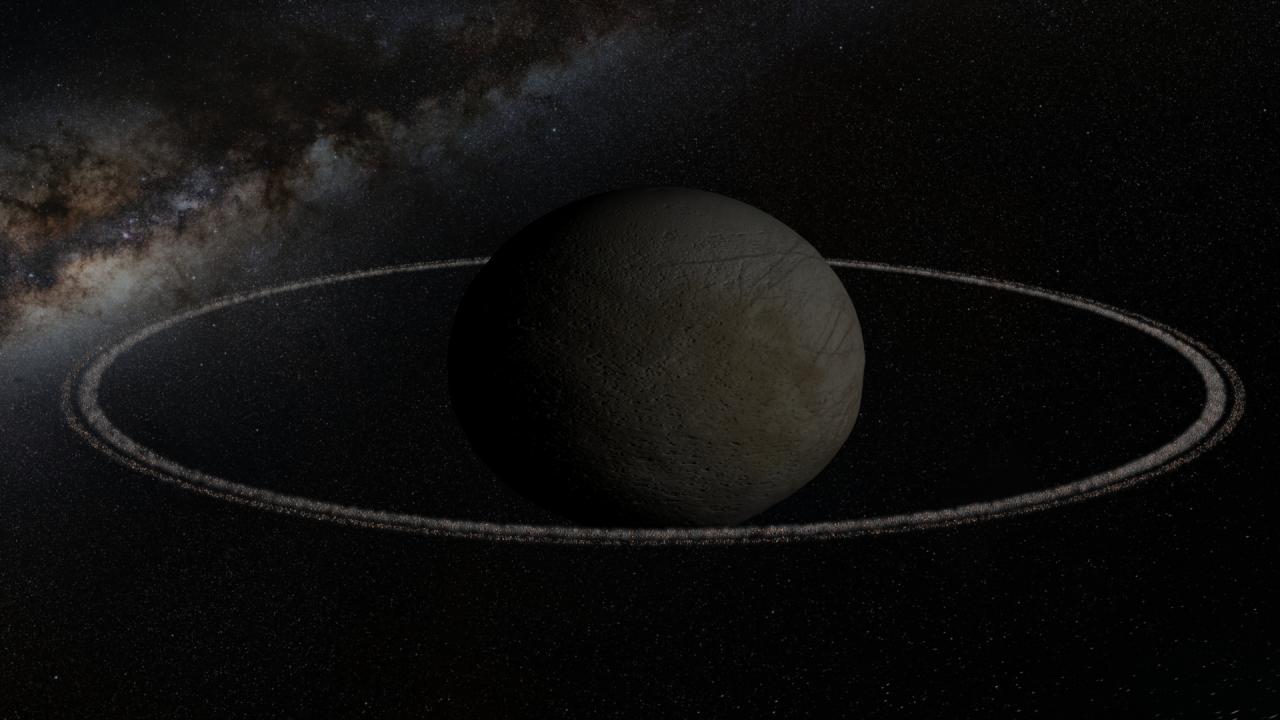A system of rings around a body of the Solar System which is not a planet has been spotted for the first time
Chariklo, an object 250 kilometers in diameter has two rings around it possibly composed of water ice. The finding, involving researchers from the Institute of Astrophysics of Andalusia (IAA-CSIC), was made possible by a stellar occultation
Until recently, it seemed like systems of rings were an exclusive trait of giant planets like Jupiter, Saturn, Uranus and Neptune. However, a small object only two hundred and fifty kilometers in diameter has just joined this small group: a stellar occultation has shown that (10199) Chariklo, a minor planet situated between Saturn and Uranus, has two dense rings around it possibly made of water ice. The finding, published today in Nature magazine, implies that rings may be more common structures than was thought until now, at least in the outermost regions of the Solar System.
The discovery was made by observing, from eight different locations, the passing of Chariklo in front of a star—an occultation—which produced unexpected results. Besides the typical events at the beginning and the end of the occultation, astronomers found two other short events that were difficult to account for.
"We were very biased by the idea that short occultation events should be due to material that Chariklo ejected in jets, like comets, because this object has some properties and even an orbit similar to that of comets,” says José Luis Ortiz, researcher at the Institute of Astrophysics of Andalusia (IAA-CSIC), involved in the finding.
"After many trials with the data I realized we were detecting material that was on an ellipse around Chariklo, forming a ring similar that of Saturn. Everything started to become clear; not only did all the pieces fit into the puzzle but we were able to explain other strange phenomena that had been observed years before,” the astronomer continued.
Chariklo is the biggest of a group of objects called centaurs, spread over a wide area between Jupiter and Neptune, which share characteristics with comets as well as with asteroids. Between 1997 and 2008, Chariklo underwent a heretofore unexplained decrease in glow, accompanied by the disappearance of the signal that indicates the presence of ice.

Artistic representation of Chariklo and his system of rings (IAA).
"We believe the water ice is not on the surface of Chariklo but in its system of rings. When we failed to detect the ice, it was because the rings were at a right angle to us and we could hardly see them because they were so thin,” says René Duffard, researcher at IAA-CSIC, involved in the finding. "We know that Saturn’s rings are to a large extent made up of water ice, so Chariklo’s rings would be like a small version of Saturn’s,” he concludes.
The rings, separated by a narrow dark strip, are seven and five kilometers wide, respectively, and have a mass equivalent to a frozen body four kilometers in diameter. Their position indicates either that we are dealing with a recently formed system or that there exists a body—what is usually known as a shepherd satellite—that contributes to constraining the rings but which hasn’t been detected yet.
Although astronomers are considering different explanations for the origin of the rings, it is highly likely that they are related to satellites which may have impacted Chariklo and left a disk of “rubble” around it. Even though the discovery of rings on a minor planet seems to point to their being more common structures tan was previously thought, for the moment Chariklo remains an exceptional object.
This discovery was made possible by a network of telescopes in Chile, Brazil, Argentina and Uruguay, some of which were used remotely from Granada by Nicolás Morales, observer for the IAA-CSIC research group. Due to the small size and remoteness of Chariklo, the system looks like a dot of light even through the most powerful telescopes, and only the technique of stellar occultation could reveal the existence of rings (even though we have no image of them).
F. Braga-Ribas et al. A ring system discovered around the asteroid-like object (10199) Chariklo. Nature. DOI: http://dx.doi.org/ 10.1038/nature13155
Instituto de Astrofísica de Andalucía (IAA-CSIC)
Unidad de Divulgación y Comunicación
Silbia López de Lacalle - sll[arroba]iaa.es - 958230532
http://www.iaa.es
http://divulgacion.iaa.es

